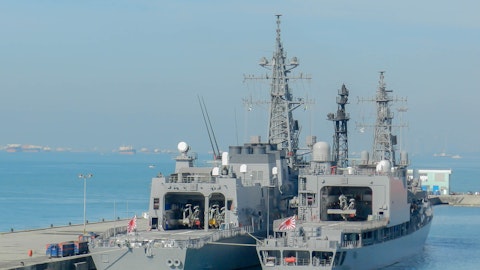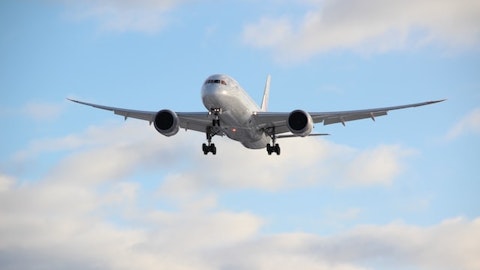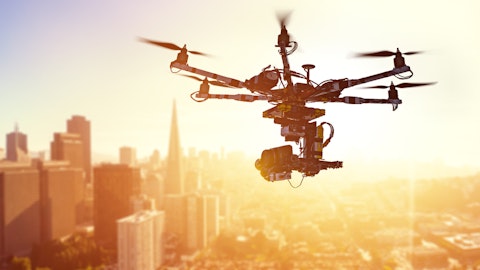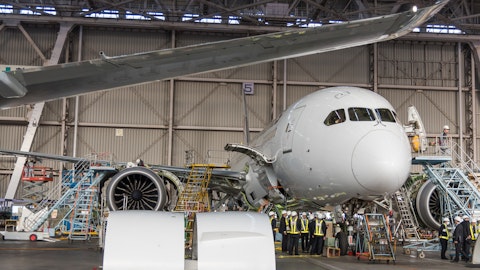AeroVironment, Inc. (NASDAQ:AVAV) Q4 2023 Earnings Call Transcript June 27, 2023
AeroVironment, Inc. misses on earnings expectations. Reported EPS is $0.99 EPS, expectations were $1.01.
Operator: Good day and thank you for standing by. Welcome to the AeroVironment Fiscal Year 2023 Fourth Quarter and Full Year Conference Call. At this time, all participants are in a listen-only mode. After the speakers’ presentation, there will be a question-and-answer session. (Operator Instructions) Please be advised that today’s conference is being recorded. I would now like to hand the conference over to your speaker today Jonah Teeter-Balin with AeroVironment. Please go ahead.
Jonah Teeter-Balin: Thanks, and good afternoon, ladies and gentlemen. Welcome to AeroVironment’s fiscal year 2023 fourth quarter and full year earnings call. This is Jonah Teeter-Balin, Senior Director of Corporate Development and Investor Relations. Before we begin, please note that certain information presented on this call contains forward-looking statements within the meaning of the Private Securities Litigation Reform Act of 1995. These statements involve many risks and uncertainties that could cause actual results to differ materially from our expectations. Further information on these risks and uncertainties is contained in the company’s 10-K and other filings with the SEC in particular in the Risk Factors and forward-looking statements sections of these such filings.
Copies are available from the SEC on the AeroVironment website or from our Investor Relations team. This afternoon we also filed a slide presentation with our earnings release and posted the presentation to the Investors section of our website at avinc.com under Events and Presentations. The content of this conference call contains time-sensitive information that is accurate only as of today, June 27th, 2023. The company undertakes no obligation to make any revision to any forward-looking statements contained in our remarks today or to update them to reflect the events or circumstances occurring after this conference call. Joining me today from AeroVironment are Chairman, President, and Chief Executive Officer, Mr. Wahid Nawabi; and Senior Vice President and Chief Financial Officer, Mr. Kevin McDonnell.
We will now begin with remarks from Wahid Nawabi. Wahid?
Wahid Nawabi: Thank you, Jonah. Welcome, everyone, to our fiscal year 2023 fourth quarter earnings conference call. I will start by summarizing our performance and recent achievements, after which, Kevin will review our financial results in greater detail. I will then provide information related to our expectations for fiscal year 2024, after which, Kevin, Jonah and I will take your questions. I’m pleased to report that the fourth quarter results exceeded most of our expectations and we set records across many key financial metrics. Our key messages, which are included on slide number three of our earnings presentation are as follows. Fourth quarter revenue rose to $186 million, a 40% increase compared to the fiscal year 2022 fourth quarter, while the product revenue nearly doubled year-over-year to just under $142 million.
Second, for the full year, revenue increased to $541 million versus $446 million last year, representing 21% growth. This makes it sixth consecutive years of top line growth. Third, our funded backlog also doubled from fiscal year 2022 to set another record at $424 million. This backlog was driven by more than $750 million in bookings throughout fiscal year 2023, reflecting strong demand for our solutions led by our small UAS or SUAS, and Tactical Missile Systems or TMS businesses. And fourth, given recent performance trends and our visibility into upcoming quarters, we’re providing fiscal year 2024 guidance that reflects nearly 20% growth in revenue, higher margins and improved bottom line results. The fundamentals of our business are strong and we’re well-positioned for significant expansion and value creation in fiscal year 2024 and beyond.
The improvement in the fourth quarter revenue was primarily due to higher SUAS and TMS sales up [60%] (ph) and more than 100% respectively compared to the prior year period. These results reflect ongoing demand for our Switchblade and Puma products. Gross margin for the fourth quarter was $68.4 million, an increase of 41% versus last fiscal year’s $48.6 million. Our gross margin as a percentage of sales was approximately 37% in both periods. As previously discussed, we expect gross margins to remain strong in fiscal year 2024, as our revenue mix continues to shift to more favorable product sales. As Kevin will cover in a moment, our pro forma bottom line profitability metrics were also much stronger this quarter. This improvement was primarily driven by higher revenues, which more than offset increased operating expenses.
This quarter caps a record year for AeroVironment. By carefully managing through challenges of the past few years such as supply chain constraints, labor shortages, and inflationary pressures, we have accelerated our growth and success. Given our current backlog and robust demand for the company’s broad portfolio of innovative unmanned solutions, we stand at the inflection point of a new phase of growth. I want to thank our investors for their continued support, especially as we enter this new chapter. As always, we’re committed to delivering value to our shareholders and visibility into our progress. Finally, we’re deeply honored and extremely proud of the growing level of assistance we have provided to our country and allies including Ukraine.
Before we discuss each segment, I want to address the recent news that AeroVironment was not selected by the US Army to proceed further with Increment 2 of the Future Tactical Unmanned Aircraft Systems, otherwise known as FTUAS. While we’re disappointed, we have fully assessed the US Army’s evaluation process and submitted a request for further clarification. We remain confident that the JUMP 20 UAS is the most versatile and cost-effective solution and the Group 2, 3 UAS market today and will continue to focus on meeting the current needs of our customers. We are humbled and honored to support the Ukraine defense efforts as the only Group 2, 3 UAS solution named in the recent US aid package. The FTUAS Increments we have been awarded to date did not comprise significant revenue for AeroVironment.
We recorded a non-cash charge of $190.2 million in the fourth quarter related to the MUAS business and Kevin will discuss its details further shortly. Importantly, the army’s decision will not have a material impact on near-term revenue growth. As we look ahead, we will focus on areas where we can improve to ensure we meet our customers’ needs. Further, we remain focused on winning other key programs by continuing to leverage the strength of our robust portfolio of innovative unmanned solutions. Despite our exit from FTUAS Increment 2, we remain bullish on our Medium UAS or MUAS product line. The JUMP 20 stands apart in its ability to perform in contested environments with an unmatched capacity to carry on payloads and we believe it’s the best Group 2, 3 solution on the market today.
There are multiple domestic and international opportunities, which we are currently pursuing that present significant growth potential in the coming years. Now shifting gears to other product lines. Our SUAS business delivered a record year of performance on the back of our largest-ever foreign military sales award and support of Ukraine. We’re proud that our Puma systems have again and again proven themselves on the battlefield and are providing scouting and support for all US supplied artillery weapon systems deployed in Ukraine. We expect SUAS revenue to remain strong in fiscal year 2024. We have also launched several new products and additional enhancements to our SUAS portfolio and expect sales of these solutions to be a meaningful component of future revenues.
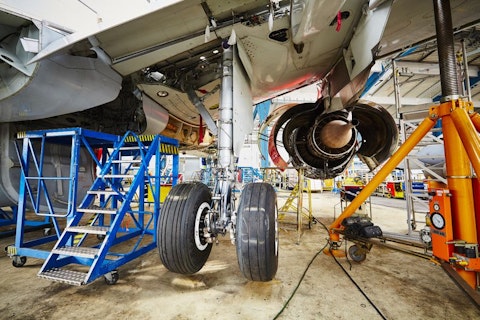
Copyright: chalabala / 123RF Stock Photo
Our TMS business product line represents a significant growth opportunity for the company. Total TMS revenue for the quarter more than doubled year-over-year, but this is only the start. The conflict in Ukraine and our Switchblade success on the battlefield has accelerated the global trend towards increased adoption of loitering munitions. We now have orders from four allied nations. More importantly, the US government has recently approved us to market and sell Switchblades to nearly 50 allied countries, up from 20 countries last year. Given the current level of global interest, the record backlog and growing demand in Switchblade, we expect our TMS business to be a leading growth driver for the company moving forward. Our Unmanned Ground Vehicles or UGV product line achieved record levels of performance in the fourth quarter.
Similar to our TMS segment, UGV revenue more than doubled year-over-year, resulting in the unit’s best year since its inception. We’re also marking solid progress providing telemax and tEODor ground vehicles to Ukraine under an accelerated schedule. And these vehicles are performing well on the battlefield. We expect another growth year for this business in fiscal year 2024. Our HAPS product line continues to make solid progress in the development of next-generation Sunglider, a successfully commercialized stratospheric-based telecommunication services and partnership with SoftBank. We also recently received our first contract from the US DoD for this unique capability and are actively pursuing multiple other defense opportunities. Given the current conflicts around the world, we believe that the defense market for HAPS represents a multi-billion dollar long-term growth opportunity and we’re well positioned to supply this large market with our highly differentiated Solar HAPS solutions.
And finally, our MacCready Works Advanced Solutions continues to establish AeroVironment as a leading global supplier of AI, machine learning and autonomy-powered unmanned systems. With the support of this team, AV is designing systems that will anticipate and evolve with the needs of our military. These include expandable autonomous capabilities that allow our UAS to continue operations without persistent radio link and advanced artificial intelligence and machine learning algorithms that can sense, analyze, and navigate the battle space. We have deployed some of these capabilities within our product lines already and expect more in the future. This segment also continues to pursue new and exciting lines of business such as space robotics and contested logistics that could become new business segments of their own for AeroVironment.
MacCready Works grew significantly in the fiscal year 2023 and we expect to see additional top line growth in fiscal year 2024. Before turning the call over to Kevin, I would like to note that starting in Q1 of this fiscal year AeroVironment will define our segments differently to reflect the larger broader nature of our products and services and their associated end markets. Going forward, we will provide color on three segments. Combining our SUAS, MUAS, and UGV product lines will be combined into a new Unmanned Systems segment. Our Tactical Missile Systems will now become Loitering Munition systems and our MacCready Works segment will include the current MacCready Works operations along with HAPS and other customer-funded R&D programs. We look forward to sharing more on this new segmentation next quarter.
With that, I would like to now turn the call over to Kevin McDonnell for a review of the fourth quarter financials. Kevin?
Kevin McDonnell: Thank you, Wahid. Today I will be reviewing the highlights of our fourth quarter and full year fiscal 2023 performance, during which I will occasionally refer to our press release and earnings presentation available on our website. We ended the year extremely strong in terms of bookings, backlog, revenue, adjusted gross margins and adjusted EBITDA. Wahid will go over the guidance for FY’24 next. But we are set up for a strong revenue and EBITDA growth in FY’24. However, as Wahid mentioned, we recorded a non-cash charges in the fourth quarter related to our Medium UAS business. I will cover these shortly. Let me begin by providing some more detail on the quarter — revenue on the quarter. Revenue for the fourth quarter of fiscal 2023 was at a new record level of $186 million, an increase of 40% from the fourth quarter of fiscal 2022.
Slide five of the earnings presentation provides a breakdown of revenue by segment for the quarter. Our largest segment during the quarter was Small UAS with a record $94.6 million of revenue, up from last year’s $59.2 million. We saw a healthy mix of business within Small UAS with Ukraine shipments just over 40% and the remainder from new customers and upgrades to existing customers. In other words, we are seeing strong demand beyond just Ukraine. Tactical Missile Systems or TMS recorded revenue of $42.5 million compared to $20.2 million last year during Q4. It is also worth noting that we received $125 million of orders for our TMS products in Q4, bringing the total for the year to just over $230 million, showing the strength of domestic and global demand for the Switchblade products.
Revenue from the other segment, which includes UGV, HAPS and MacCready Works businesses increased year-over-year to $40.6 million versus $30.1 million in the fourth quarter of fiscal 2022. Our Medium UAS segment finished with revenue for the quarter of $8.3 million, a 33% decrease compared to the fourth quarter of fiscal year ’22. The reduction of revenue was a result of the lower COCO service revenue. For the year, revenues hit a record $540.5 million, which is 21% higher than fiscal 2022. We also had record bookings for the year at over $750 million. This mostly organic revenue growth reflects the strong global demand for our products. Turning to gross margins. In slide five of the earnings presentation, we show a breakdown between product and service revenues.
Specifically during the fourth quarter, product revenues accounted for 76% of total revenues, an increase from 56% in the corresponding quarter of the previous year. The product mix shift was expected due to the substantial increase in sales of Small UAS and TMS products. Slide six of the earnings presentation shows the trend of adjusted product and service gross margins, while Slide 12 reconciles the GAAP gross margins to the adjusted gross margins, which excludes intangible amortization expense and other non-cash purchase accounting items. In the fourth quarter, GAAP gross margins remained steady at 37%, identical to the fourth quarter of the previous year. On the other hand, the non-GAAP adjusted gross margins slightly decreased to 39% from 40% in the prior year.
Adjusted gross product margins for the quarter were 47% versus 49% in the fourth quarter of last fiscal year. The year-over-year decline in adjusted product gross margin can be attributed to the higher mix of TMS revenue. In terms of adjusted service gross margins, the fourth quarter was at 13% versus 28% during the same quarter last year, primarily due to the accelerated depreciation charges related to our COCO service assets of $4.4 million. For the full year, GAAP gross margins ended at 32% in fiscal 2023 the same level as last fiscal year and adjusted gross margins decreased from — to 35% from 36%. The decrease in adjusted gross margins was primarily due to the $[14.5] (ph) million of accelerated depreciation from our Medium UAS COCO assets.
We expect adjusted gross margins to improve to the high ’30s in FY’24 with the shift to more product revenues and transition of service margins to a more normal level. In terms of adjusted EBITDA, slide 13 of our earnings presentation shows a reconciliation of the GAAP net loss to adjusted EBITDA. In the fourth quarter of fiscal 2023, adjusted EBITDA was $46 million, representing the increase of over 60% from last year. The main factor contributing to this increase was higher sales volumes, which was partially offset by increased SG&A expenses and investments in R&D. For the full fiscal year 2023, adjusted EBITDA was $90 million, representing the increase of 43% from last year. SG&A expense, excluding intangible amortization and acquisition-related expenses for the fourth quarter was 13% of revenue and 15% of revenue for the fiscal year 2023, compared to full fiscal year 2022 of 16% of revenue.
R&D expense for the fourth quarter was 9% of revenue and 12% for full fiscal year 2023. We will continue to run R&D in the 10% to 12% range as we invest in new products and upgrades to existing products to meet the evolving needs of our customers. Now turning to GAAP earnings. During the fourth quarter, the company encountered a net loss of $160.5 million, of which $190.1 million was a result of a non-cash charges related to the Medium UAS business. Of the total non-cash charge, $34.1 million was the acceleration of intangible asset amortization related to a particular customer. This accelerated amortization was reported as SG&A expense in the quarter. The remaining $156 million of the total non-cash charge was a goodwill adjustment from the revaluation of the Medium UAS goodwill from the Arcturus acquisition as a result of recasting of the future cash flows as a result of the FTUAS Increment 2 loss.
Although we remain optimistic about the Medium UAS business in both the short and long-term, current business conditions dictate these adjustments. Slide 10 shows the reconciliation of GAAP and adjusted or non-GAAP diluted EPS. GAAP EPS loss was $6.31 per share in the quarter and a loss of $7.04 per share for the year, both reflecting the non-cash charges discussed previously. In terms of non-GAAP EPS, the company posted adjusted earnings per diluted share of $0.99 for the fourth quarter of fiscal 2023 versus $0.12 per diluted share for the fourth quarter of fiscal 2022. Full year adjusted EPS was $1.26 per share versus $1.06 per share in fiscal 2022. Turning to our balance sheet. Total cash, restricted cash and investments at the end of the quarter was $156.5 million, which is an increase of $51.9 million from the third quarter of fiscal 2023.
In addition, we reduced our debt by over $50 million during fiscal 2023. We did see an increase in working capital during the fourth quarter, driven primarily by increased accounts receivable related to the higher sales volume. As indicated in prior quarters, we expect to see continued increases in inventories and other working capital to support a higher level of business and minimize exposure to the supply chain issues and long lead times. We continue to have a strong balance sheet with over $150 million of cash, restricted cash and investments and $100 million working capital facility with no outstanding balance. Now I’d like to turn things back to Wahid.
Wahid Nawabi: Thanks, Kevin. The macro-environment continues to support greater adoption of unmanned solutions. The Ukraine conflict has accelerated existing trends towards greater adoption of distributed solutions such as small drones and loitering munitions by demonstrating their effectiveness against well-equipped adversaries. These solutions are highly impactful, but typically far less expensive, have shorter lead times and enable an agile force structure compared with larger traditional manned systems. Further, these solutions enable countries with smaller defense budgets to secure effective defensive capabilities and provide a deterrent to adversaries. We believe these global trends, combined with our market-leading technology-driven unmanned solutions will support our growth in fiscal year 2024 and for years to come.
I’m now pleased to provide our guidance for fiscal year 2024 shown on slide number seven, as follows. We anticipate revenue of between $630 million and $660 million. We forecast net income between $50 million to $58 million or $1.91 per diluted share to $2.21 per diluted share. Non-GAAP adjusted EBITDA of between $110 million and $120 million and non-GAAP earnings per diluted share, excluding acquisition-related costs, amortization of intangible assets and other one-time expenses of between $2.30 and $2.60. We expect to deliver adjusted EBITDA of between 16% and 18% of revenue for the full fiscal year, while R&D investment is anticipated to remain between 10% to 12% of revenue. Our funded backlog at the end of fiscal year 2023 was a record $424 million.
As a result, visibility to the midpoint of our fiscal year ’24 revenue guidance range is at 78%. This visibility sets us up for a strong fiscal year 2024. We expect first half revenue to represent almost 50% of the full fiscal year. Further, Q1 revenue should account for nearly 40% of first half revenues. Before turning the call over for questions, let me once again summarize the key points from today’s call. First, we delivered record fourth quarter performance and met or exceeded our expectations. Second, full year revenue was also a record, marking our sixth consecutive year of top line growth. Third, our funded backlog is at record levels, reflecting strong global demand for our solutions, and fourth, the fundamentals of our business are as strong as they’ve ever been, and we expect fiscal year 2024 to be yet another record setting year for the company.
I’m also excited to inform you that Admiral Phil Davidson recently joined our Board of Directors. Admiral Davidson’s outstanding qualifications and credentials speak for themselves. His guidance, informed by his extensive and relevant military expertise will be key in enabling us to better support our customers while capitalizing on the significant opportunities in front of us. I would like to thank our talented team for their dedication and hard work and helping our customers achieve their vital missions. Based on their perseverance, the faith entrusted in us by our customers, and the ongoing support of our investors, we believe we’re in the best shape ever for a record setting fiscal year 2024. We remain committed to delivering superior returns for our investors.
And with that, Kevin, Jonah and I will now take your questions.
See also 15 Best Beach Towns for Retirement and 20 American Cities with the Lowest Uninsured Rates.
Q&A Session
Follow Aerovironment Inc (NASDAQ:AVAV)
Follow Aerovironment Inc (NASDAQ:AVAV)
Operator: Thank you. [Operator Instructions] Our first question comes from Ken Herbert with RBC Capital Markets. You may proceed.
Kenneth Herbert: Hey, good afternoon, Wahid and Kevin and Jonah.
Wahid Nawabi: Good afternoon, Ken.
Kevin McDonnell: Hi, Ken.
Kenneth Herbert: Hey, nice end of the fiscal year, Wahid. I wondered if you could provide a little more granularity on the revenue guidance for fiscal ’24. And specifically, can you comment on the implied assumptions for growth within sort of the current TMS and SUAS segments?
Wahid Nawabi: Thanks, Ken. Of course, our team did a fantastic job. Very proud of the achievements especially given the challenges that we’ve had in the large quarter, a record year in terms of backlog, revenue, all across the board, pretty much very strong results for fiscal ’23. And more importantly, as you mentioned, it sets us up really, really well for fiscal year ’24, with again another record-funded backlog and 78% visibility toward the midpoint of our guidance. In terms of growth, we expect both TMS and unmanned systems or SUAS product lines to have significant growth in the coming year. The demand for our systems and our products are pretty broad across the board and not just in the United States, but also internationally.
So it’s a pretty diversified set of customers, opportunities and product portfolio that’s driving and fueling our growth. We obviously expect to grow very significantly next year, close to almost $100 million on top of a very strong growth year. And the other thing that’s really important also to note is that the strong backlog and visibility is allowing us to level load the quarters, which allows us to have a roughly evenly first half, second half, maybe first half is slightly lower than 50%, but close to it and then the first quarter being almost 40% of the first half’s revenue. So all those things as a result of really strong demand for our products across the market and a change in the paradigm, I see an inflection point here in the market where small unmanned systems as well as loitering munitions is really changing the way that military think about getting prepared to defend themselves and fight wars in the future.
Kenneth Herbert: Yeah. Thanks, Wahid. And I think you mentioned that your — you’ve got an approval now to sell the Switchblade into, I think, 50 countries. Can you just comment on actually how many countries you’ve been selling the system into? And what’s the runway as you think about sort of capturing or obviously getting sales eventually into all 50 of those countries?
Wahid Nawabi: Sure. So Ken, as I mentioned, we have orders so far that we have booked from four allied countries to date. However, the list, you’re right, has grown. The list of countries that the US DoD and the State Department has given us an approval to market and eventually sell to basically more than doubled from 20 before last year to close to 50 countries now. We’re actively involved. So that’s by itself is a very large increase, and it shows, a) that there are a lots of countries that are in need of this and they would like to have this capability, and b) our track record and performance in Ukraine and with the US military has demonstrated the capability and the value of this system. And so US DoD has been very encouraging and positive and supporting us to increase that list of 50 countries.
